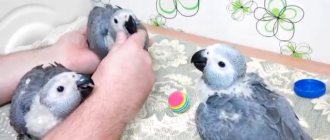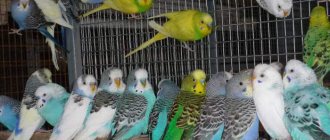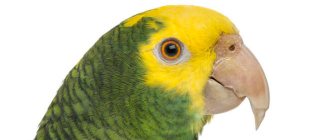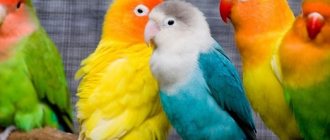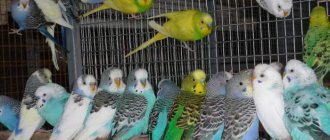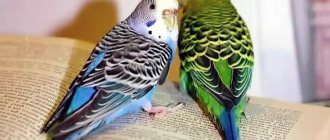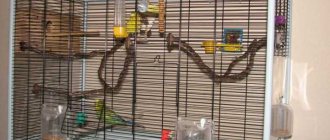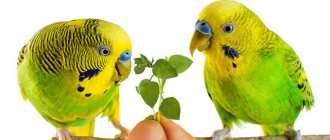- home
- Parrot
- FAQ
05/16/2019 The high demand and popularity of budgies as pets is due not only to their attractive appearance, cheerful disposition and unpretentiousness, but also to the ability to teach budgies to talk. The bird itself will not speak. But if the owner pays due attention to the training and patiently works with the feathered pet day after day, the training will bring results.
Can a budgie learn to say words in 1 day of training?
The most easily trained talkers are the Gray and Macaw parrots. Teaching budgerigars to speak is noticeably more difficult. It will take a lot of time and will require patience and diligence from the teacher. The first word spoken by the wavy is preceded by numerous hard trainings.
Training a feathered pet takes on average 3–5 months. At the same time, in order for the parrot to speak, classes with the bird must be regular throughout the entire period of training. This requires a certain discipline and punctuality from the owner.
The exact time when budgerigars begin to speak is impossible to determine. Each bird is unique and inimitable, each has different abilities, and therefore they achieve different levels of success in learning. One wavy learns faster, the other slower. But still, we have not yet encountered any brilliant birds who spoke before 2-3 months of training. Therefore, the answer to the frequent question whether it is possible to teach a wavy to speak in 1 day is a firm “no.”
Nuances of training
After the bird utters the first word, things will go noticeably faster - an already speaking budgie absorbs new information and remembers new words much more easily than a bird that has not yet made a human sound.
The parrot makes its first progress in training in stages:
- He listens and tries to catch the sound of the word he is learning, pronounced by the owner.
- Opens its beak in an attempt to repeat the word after the owner.
- Responds to a word with a sound vaguely similar to it.
- With each subsequent attempt, the sound produced becomes more and more similar to the word being learned.
The faster a bird goes through these stages of training, the more talented it is. This means that the greater success she will achieve in developing the ability to speak.
It is especially worth noting that you cannot start teaching a parrot to talk immediately after it appears in the house. It is necessary to give him time to adapt to new living conditions. Before you start training your feathered pet, you need to get to know him, win his trust and make friends. On average, all this takes 1–2 weeks. Only when the bird gets comfortable in its new home, and also considers its owner a friend and trusts him completely, can you begin to train it.
Wavy can remember several hundred words. The parrot does not understand their meaning, but it grasps the cause-and-effect relationship, which allows it to use them at the right time. You can teach a budgerigar to speak only through live communication - a recording turned on near the cage will not help.
Training will also be ineffective if the bird has someone to communicate with in its native language, i.e. she lives with a relative. However, this rule does not apply if this relative is speaking. It is not uncommon for a parrot that can already speak to teach its neighbor words from its own vocabulary. But this process is not controlled by the owner, so it is impossible to predict the result of the proximity of speaking and non-speaking parrots.
Talk to Gray
“African gray parrots have a reputation for being smart and not loud,” Matti Sue Athan, a parrot behavior consultant for the International Association of Animal Behavior Consultants (IAABC), and author of “The Behaved Parrot,” said in an interview.
Atan reported that independent development of playing skills also affects the development of the bird’s vocal abilities. Special toys for birds, intensive training, which the bird masters in the period between the appearance of plumage and the onset of puberty, is the key to a well-mannered parrot with good vocal and conversational abilities. If the Gray is deprived of privileges with toys, then this may later affect his behavior - excessive loudness and destructive behavior in general.
On video: talking gray parrot
The owner of a gray gray cat named Rocket was amazed by his ability to learn new words every week, and now she knows exactly which parrots speak best. She said that he is prone to self-learning : “Once Rocket spied on me while eating food, and suddenly said: “I want some...”. I told him: “Rocket, go eat your grain.” He continued to insist: “I want some...”. Then he started doing what I call a somersault. It went up the front of the cage to the top, and down the back wall. He saw that his trick still didn’t work (and it was thanks to her that he always got what he wanted before). And when I again repeated that he should go eat his bird food, he said: “I want food... Please!” I was amazed at his persistence, and besides, he had never used the word “Please” before. Of course, Rocket will get his share of goodies."
Another owner of a Gray Gray, who currently has a vocabulary of 300 words, said that when the bird was brought from a pet store at the age of 4 months, she immediately greeted the owner with the word: “Hello.” The parrot said hello every time he saw a person. And a little later, he often mixed different words with the name of the mistress, teased her and laughed. “He knew he was joking and entertaining me. It was great,” says the owner. “He also learned several songs, and if you start singing the first verse, he will definitely sing along with the second.”
At what age should a budgie be taught to talk?
Young budgies learn more successfully than their adult counterparts. Young animals remember new words faster and demonstrate more accurate pronunciation. Therefore, if you want to teach your feathered pet to talk, it is recommended not to delay the start of training.
The optimal period for the development of speaking abilities in a wavy bird covers several months. It is counted from the 35th day from the moment the bird begins independent life (i.e. leaving the parental nest) and continues until the age of six months. The learning ability of a six-month-old parrot is reduced. To achieve results, both the parrot and his owner-teacher will have to put in much more effort. Each word will need to be repeated many times, which will take much more time.
The earlier the lessons begin, the more effective they will be. Therefore, it is advisable to start training your parrot immediately after its adaptation.
Choosing a pet
We didn’t decide on a dog or a cat right away; fish and hamsters are past stages from our childhood. Therefore, the choice fell on a bird, and if we take it, then a talking bird! The most budget option is a budgie. That's what they decided on. And then one fine day my husband brought home a parrot, Kesha.
Kesha immediately became everyone's favorite: he was not afraid of hands, flew all over the apartment, punched paper with his beak and gently bit his earlobe. He learned to enter the cage on command, with the help of a pointer: he jumped on it as soon as it was brought to him, and from this perch he meekly jumped into his house. But no matter how much we repeated: “Kesha is good,” the parrot remained silent. The bird was extremely stubborn and silent, he didn’t even chirp!
How does a parrot's gender affect its ability to speak?
It is a proven fact that it is easier to teach a male wavy to talk than a female wavy. The average training time applies mainly to male parrots. With feathered girls everything is much more complicated. Teaching them to speak is very difficult - maximum patience will be required from the owner-teacher.
The results of training a girl parrot appear later than those of a feathered boy. But the effort and time spent training the female is worth it. Wavy beauties have one advantage over boy parrots in their ability to speak. A female parrot speaks much more clearly and pronounces learned words more accurately than most males. And this is despite the fact that parrots of both sexes have the same sound apparatus - both boys and girls lack vocal cords.
Essentially, parrots are ventriloquists. The sounds they make come from the lower part of the larynx, thanks to which budgerigars can talk even with their beak closed. In the area of the bird's chest there is a kind of chamber with external vocal membranes.
Hearing a human conversation between budgerigars is a great success and success, and even more so to communicate with a feathered girl.
Six tips to follow when learning to speak
When starting to train a bird, it is important to remember that she does not realize what the words she is learning mean, but simply remembers and repeats the sounds after the person, often linking them in her mind to certain events and situations.
In order for the training to be as effective as possible, certain rules should be followed:
- Meet and make friends with a feathered pet. By the time training begins, the bird must not only be adapted to new living conditions, but also tamed. The parrot must trust the owner and be open to contact. Training will only bring results if the bird does not see danger in its teacher. Otherwise, she will not only not listen, but every lesson will become stressful for her. Of course, nothing good will come from such training.
- Choose the first word to learn. It is advisable that this word be the name of the parrot - this way the owner teaches the bird both to talk and to respond to its name. Regardless of which word is chosen, it must be pronounced often and in its entirety. If the bird cannot repeat the word completely, you need to break it down into individual sounds and teach it in parts.
- Maintain eye contact and pronounce the word correctly. It is very important during training to look directly at the bird, or rather, into its eyes. This will let the bird know that the owner’s speech is addressed specifically to it.
- Give the bird time to react to the word. There is no need to continuously repeat the same word. It is important to present it in the form of an address to the bird, while giving the pet a little time to react to what it hears.
- Conduct lessons daily. The recommended duration of each is 5–20 minutes at the beginning of classes and 30–40 minutes later. The duration must be adjusted according to the student’s mood. It is advisable to conduct lessons at the same hours and, if possible, twice a day. It is very important to stick to your schedule and not miss classes.
- Praise your parrot and reward him with treats, even if he has not yet achieved significant learning victories.
During the lesson, both the teacher and the feathered student should be in a good mood. You should not disturb the bird with training when it is playing, or wants to sleep or eat.
We continue to teach Volnistik conversation
During training, you need to pay attention to your intonation. Birds perfectly sense a person's mood. So, you need to talk to birds emotionally (kindly, kindly), but not shout - this will scare away the parrot. And monotonous speech can quickly get boring for them.
It is worth paying attention to the reaction of a budgie to certain words. If he gets worried, starts running fussily from side to side, or reacts in some other way, then this word is like a signal. It is better not to say it again during training.
Exercises with budgies should be enjoyed. Organize activities in the form of a conversation, that is, treat your pet as if you were a small child.
It is necessary to pronounce a word or phrase at least ten times during the entire lesson, but do not mindlessly jabber. You always need to maintain emotional intonation so that the parrot is interested in listening. The parrot expresses its interest by its attentive gaze, following you during training, and by fluffing its feathers.
It is important to notice the budgerigar's attempts to speak and reward his efforts with some kind of treat. This will encourage the bird to repeat the learned word over and over again. At first, the wavy will simply open its beak, watching you speak. Then he will try to repeat the sound that he heard from you earlier.
You cannot scold a bird when it fails or is simply silent. Patience is important in training, and such emotional outbursts will only further push the bird away from classes and the desire to speak.
In order for a budgerigar to learn to say, for example, the word “delicious” when feeding, you need to repeat this word exactly when you put food in the feeder. If you want your feathered pet to say other phrases, in other situations you must also repeat those words that you would like to hear from the parrot later.
Budgerigars that have already learned to speak several words tend to form new words by swapping syllables in one word or syllables in different words. For example, from the phrase “Roma, hello,” the parrot comes out “roaring.”
It is worth noting that parrots remember rhyme well. Try to choose a rhyme in the form of a simple word for each word that you want to teach your pet.
Of course, live communication with a parrot during classes is effective, but in some cases, machine reproduction of your voice is also useful. For example, a voice recording can help if you are away from home for a long time. After all, training with a parrot should only be carried out by one person whom the bird trusts.
How to teach an adult budgie to talk?
You can teach a wavy to talk at any stage of the bird's life. But the older the feathered student, the more difficult science will be for him, and accordingly, the more effort the owner will have to make to teach him. Adult wavy fish take much longer to learn to speak than their young relatives.
It is better to abandon the idea of teaching an adult female to speak altogether. Even at a young age, parrots study longer than their male relatives. You will have to spend too much time on an adult female. Besides, there is no guarantee that she will eventually speak.
It is better to start training male parrots. Even when working with adult males, achieving the desired result is not so long and problematic. Adult parrots should be trained following standard rules - they apply not only to young birds, but to parrots of all ages. With due diligence, the result will not take long to arrive and soon you will be able to hear an adult budgerigar talking.
When the parrot is not alone
If there is more than one parrot in the house, you need to deal with each one separately. The training process should take place in an isolated room so that other birds do not distract from the training. Parrots that live with their fellow parrots take longer to learn to speak than those that live alone. And most often they ignore human speech - they have enough communication with their relatives.
The result is successful when a pair is added to an already talking parrot. It is better if the female learns the words, and a male is placed with her. Then the “groom” tries to please his girlfriend and begins to imitate her. The female may also begin to repeat the words after the male, but it usually takes her longer.
How to teach a budgie to pronounce sounds clearly?
Birds, like people, have different capabilities and abilities. One bird can speak like an announcer, another can barely put sounds into words, and the third cannot speak at all.
You should not demand perfect pronunciation from the wavy from the very first training. Just as you shouldn’t think that a feathered pet is lazy and doesn’t try. Perhaps he is already speaking, using the maximum of the abilities given to him by nature. Or maybe he just needs more training.
In any case, you should continue studying. At each subsequent training, the parrot will improve and hone its pronunciation. If only the bird is able to speak more clearly, in time it will certainly do so.
Important information regarding training
When purchasing a parrot, those who want to teach their pet to speak should choose birds that are calm, curious, and interested in everything around them. Such birds easily become interested in human speech, and this is the first step to successful learning. In addition, the bird, of course, must be vigorous and healthy.
Before starting the lesson, it is worth taking out the toys and mirror from the cage. Otherwise, the bird will be constantly distracted from its activities by entertainment. But, of course, after training, the bird’s playing accessories must be returned to the cage. It is worth noting that a mirror can interfere with a bird’s learning, since it perceives the reflection as a fellow bird, and, accordingly, will strive to communicate with it in its native language.
When conducting lessons in a room with a bird, there should be no distractions - other people, animals, the TV on, etc. There should only be two people in the room - a teacher and a student, i.e. owner and parrot. The environment should be as calm as possible.
You need to speak not quickly, not loudly and not sharply, but at the same time emotionally. Inexpressive speech will not attract the bird’s attention, and too harsh intonations will frighten the bird. You also cannot move quickly, gesticulate, etc. – in such an environment the bird will be scared and uncomfortable. Goodwill should be felt in the voice. When learning one word, you cannot change the tone of pronunciation from lesson to lesson, as this can confuse the bird.
